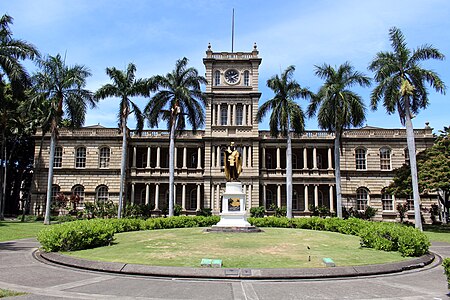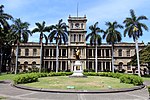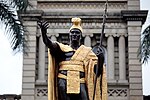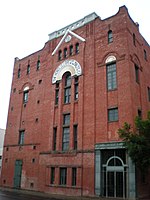Aliʻiōlani Hale
1874 establishments in HawaiiBuildings and structures in HonoluluGovernment buildings completed in 1874Government buildings on the National Register of Historic Places in HawaiiHawaii culture ... and 8 more
Hawaiian architectureHistoric American Buildings Survey in HawaiiHistoric district contributing properties in HawaiiItalian Renaissance Revival architecture in the United StatesNRHP infobox with nocatNational Register of Historic Places in HonoluluThomas Rowe buildingsTourist attractions in Honolulu

Aliʻiōlani Hale is a building located in downtown Honolulu, Hawaiʻi, currently used as the home of the Hawaiʻi State Supreme Court. It is the former seat of government of the Kingdom of Hawaiʻi and the Republic of Hawaiʻi. Located in the building's courtyard is the famed gold-leaf statue of Kamehameha the Great.
Excerpt from the Wikipedia article Aliʻiōlani Hale (License: CC BY-SA 3.0, Authors, Images).Aliʻiōlani Hale
South King Street, Honolulu Hawaii Capital Historic District
Geographical coordinates (GPS) Address External links Nearby Places Show on map
Geographical coordinates (GPS)
| Latitude | Longitude |
|---|---|
| N 21.305277777778 ° | E -157.86 ° |
Address
Ali'iolani Hale (Hawaii Supreme Court)
South King Street 417
96813 Honolulu, Hawaii Capital Historic District
Hawaii, United States
Open on Google Maps









